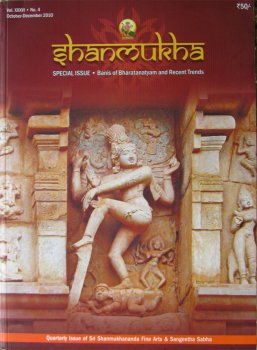
|   |

|   |
Stirring a hornet’s nest? - Kiran Rajagopalan, Chennai e-mail: kiran.rajagopalan@gmail.com June 28, 2011  In October 2010, Mumbai’s Sri
Shanmukhananda Fine Arts & Sangeetha Sabha published a
special commemorative issue of their quarterly magazine,
Shanmukha, on the banis and latest trends of
Bharatanatyam. Most of the major banis are adequately
discussed in the first half of the issue by leading
dancers, gurus and scholars including Kamala
Lakshminarayanan, Alarmel Valli, Leela Samson and Ashish
Khokar. The Vazhuvoor, Pandanallur, Kalakshetra and
Kattumannarkoil banis are each represented through single
articles by these authors. Interestingly, the Thanjavur
bani is more extensively covered in the four articles on
Kitappa Pillai (Dr. Sucheta Chapekar), Sri Rajarajeshwari
Bharatha Natya Kala Mandir (Jyothi Mohan) and
Dhandayudapani Pillai (Jayalakshmi Alva & Urmila
Sathyanarayanan). In October 2010, Mumbai’s Sri
Shanmukhananda Fine Arts & Sangeetha Sabha published a
special commemorative issue of their quarterly magazine,
Shanmukha, on the banis and latest trends of
Bharatanatyam. Most of the major banis are adequately
discussed in the first half of the issue by leading
dancers, gurus and scholars including Kamala
Lakshminarayanan, Alarmel Valli, Leela Samson and Ashish
Khokar. The Vazhuvoor, Pandanallur, Kalakshetra and
Kattumannarkoil banis are each represented through single
articles by these authors. Interestingly, the Thanjavur
bani is more extensively covered in the four articles on
Kitappa Pillai (Dr. Sucheta Chapekar), Sri Rajarajeshwari
Bharatha Natya Kala Mandir (Jyothi Mohan) and
Dhandayudapani Pillai (Jayalakshmi Alva & Urmila
Sathyanarayanan).However, the second half of the issue is quite compelling because it deals with topics intimately linked to Bharatanatyam but rarely discussed in detail. For example, B Bhanumati’s article on group choreography is especially incisive and filled with useful tips for aspiring choreographers. Rajee Narayan’s article on music is also constructive because she elaborates on raga selection for dance compositions. Anita Ratnam’s thought-provoking article on modern dance also introduces rasikas to a number of contemporary dancers in India. In addition, VP Dhananjayan candidly discusses the challenges of creating, presenting, and funding professional dance dramas in India. Bharatanatyam pedagogy in Indian institutions and in schools abroad is also examined at length by Jyothi Mohan and Rajyashree Ramesh, respectively. However, the highlight of the issue is K Subadra’s excellent article on dance criticism. The article is not only insightful but also inspiring for young artistes interested in becoming art critics. What is rather disappointing about this issue is that many of the articles on the banis just briefly mention the technical nuances that distinguish each style. Furthermore, there were no articles which compared or contrasted the salient features of one bani with another. Instead, there was a tendency to focus on a guru’s overall approach to choreography and pedagogy. An exception to this was Lalitha Srinivasan’s detailed article on the Mysore bani. She explains that this style eschews "linear" hand gestures like “pataka and tripataka” in favor of “flowery hand gestures” and that the “tribhangi is much used in abhinaya.” Such subtleties in the technique and teaching of a bani are also mentioned in Dr. Jayashree Rajagopalan’s article on Bharatanrityam. Despite the professional and aesthetic layout of the issue, some careful editing is required in that there were quite a few grammatical, spelling, and formatting mistakes. In spite of these shortcomings, it was a commendable effort by the organization to compile such an exhaustive and informative issue featuring articles by so many different artistes. The editor of this issue, Radha Namboodiri, thoughtfully remarked whether this endeavor would “stir a hornet’s nest.” Hopefully, it will be a starting point for serious discussions about the future of Bharatanatyam. Kiran Rajagopalan is a Bharatanatyam dancer presently based in Chennai. Post your comment Unless you wish to remain anonymous, please provide your name and email id when you use the Anonymous profile in the blog to post a comment. All appropriate comments posted in the blog will also be featured in the site. |